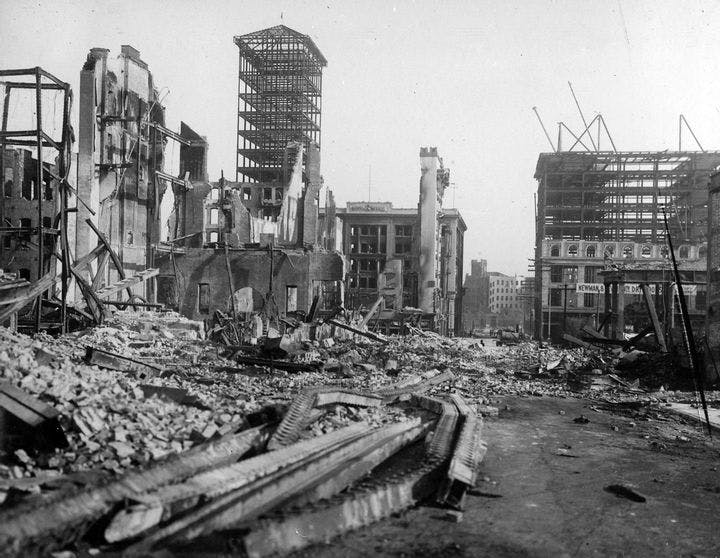Fall 2009
The Good and the Bad in the Ugly
– Troy Jollimore
The United States has failed to learn the crucial lessons that have come with environmental and political catastrophes across the 20th century.
Between the terrorist attacks of 2001 and the near destruction of New Orleans four years later, the 21st century’s first decade has given Americans ample opportunity to reflect on disaster. But, argues Rebecca Solnit in A Paradise Built in Hell, we have yet to learn the crucial lessons that such calamities ought to teach us.
Solnit—the author of an impressively eclectic series of books on subjects ranging from political activism to the English photographer Eadweard Muybridge—surveys several disasters over roughly the last century, including the 1906 San Francisco earthquake, the Mexico City earthquake of 1985, and, of course, 9/11 and Hurricane Katrina. She contends that “disaster throws us into the temporary utopia of a transformed human nature and society, one that is bolder, freer, less attached and divided than in ordinary times.”
The example that most clearly illustrates Solnit’s contention is the San Francisco earthquake, which transformed the cityscape into a patchwork quilt of “spontaneously launched community centers and relief projects.” People opened their homes to strangers or simply gathered in the streets to create improvised rooming houses and cafés. What many written reports emphasize is not the hardship but the almost party-like atmosphere that came with having survived and then rediscovered a place in the community. The joyful aftermath of a disaster, Solnit writes, “is by its very nature unsustainable and evanescent, but like a lightning flash it illuminates ordinary life, and like lightning it sometimes shatters the old forms.”
These ephemeral utopias raise radical possibilities for social rearrangement. But they go largely unappreciated, due in large part to the mainstream media’s adherence to preconceived narratives that have more to do with Hollywood disaster films, Solnit claims, than with actual events. At best, ordinary citizens are depicted as passive victims who linger in the disaster area until they are rescued by the authorities. At worst, they are seen as dangers to themselves and to each other, prone to panic, looting, and violence. Only one thing can head off chaos: swift and decisive action by the police, the military, and other authorities.
In fact, Solnit argues, the evidence does not support this anti-democratic paternalism. The public almost never panics en masse, let alone runs wild: People tend instead to be calm, clearheaded, competent, and surprisingly altruistic. Indeed, ordinary citizens are not only the first but quite frequently the best responders to disaster. Official efforts can go wrong precisely because they are excessively paternalistic, militaristic, and authoritarian.
What elites tend to fear more than the disaster—given their power and wealth, they are probably well prepared to ride out an earthquake, fire, or flood—is the social destabilization that they believe will follow. It is not the image of rising water, but of looters at the door, that haunts the nightmares of the bourgeoisie. After the San Francisco earthquake, Brigadier General Frederick Funston sanctioned his soldiers’ use of deadly force against looters—an action typical of the official response to disasters, and one that makes little sense, considering that most “looters” are not thieves, but victims scavenging for food, clothing, and other necessities.
Officials aren't the only ones who resort to violence in the defense of status quo property arrangements. By far, Solnit’s most depressing chapter describes the killing of black men by white vigilantes in New Orleans following Katrina. A virulent mixture of racism and fear—spurred by wildly exaggerated news reports suggesting that the entire area had been plunged into anarchy—led middle-aged white men to slaughter innocent people whom they saw as potential thieves and killers. The murders are an open secret in the communities in which they occurred: One of the vigilantes was filmed bragging, “It was like pheasant season in South Dakota. If it moved, you shot it.” But neither the police nor the media have shown much interest in the story. As Solnit writes, “If the facts don’t fit the beliefs, murders in plain view can go largely unnoticed.”
The Katrina murders are meant to reinforce Solnit’s claim that during disasters the underclass has reason to fear privileged elites, rather than the other way around. But the crimes also undermine her thesis that human nature, as revealed in moments of crisis, should lead us to prefer anarchic over authoritarian political structures. Despite its subtitle, Solnit’s book has less to say about post-disaster utopias than about the forces that prevent such communities from enduring, or even from arising at all. Readers of A Paradise Built in Hell may find themselves on the same page with many readers of Dante: It is hell, not paradise, that makes the more vivid and lasting impression.
* * *
Troy Jollimore is an associate professor of philosophy at California State University, Chico. His book Tom Thomson in Purgatory won the 2006 National Book Critics Circle Award for poetry.
Reviewed: "A Paradise Built in Hell: The Extraordinary Communities That Arise in Disaster" by Rebecca Solnit, Viking, 2009.
Photo courtesy of Wikimedia Commons
